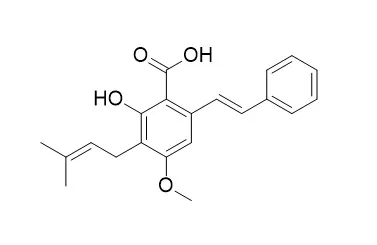| In vitro: |
| Adv Clin Exp Med . 2019 Jan;28(1):45-50. | | Cajanine promotes osteogenic differentiation and proliferation of human bone marrow mesenchymal stem cells[Pubmed: 30141283] | | Background: Seed cells - mesenchymal stem cells (MSCs) - appear to be an attractive tool in the context of tissue engineering. Bone marrow represents the main source of MSCs for both experimental and clinical studies. However, the number limitation of bone marrow MSCs (BMSCs) and decreased function caused by proliferation make the search for adequate alternative sources of these cells for autologous and allogenic transplant necessary.
Objectives: This study was aimed to investigate the roles of Cajanine isolated from the extracts of Cajanus cajan L. Millsp. in the proliferation and differentiation of BMSCs, and to discover the mechanism of proliferation of BMSCs promoted by Cajanine.
Material and methods: Bone marrow mesenchymal stem cells were cultured in high-glucose Dulbecco's Modified Eagle's Medium (DMEM) and osteogenic differentiation was induced by adding dexamethasone, ascorbic acid and β-glycerophosphate supplements. Bone marrow MSCs were cultured in medium without Cajanine or supplemented with Cajanine. The information about the proliferation and osteogenic differentiation of BMSCs was collated. The osteogenic differentiation potential of BMSCs was also assessed at the 3rd passage by Von Kossa staining. To observe cell signal transduction changes of BMSCs after culturing them with Cajanine for 24 h, the western blot analysis was performed to detect phosphorylated cell cycle proteins and activated cyclins.
Results: After osteogenic induction, the differentiation of BMSCs was accelerated by Cajanine treatment. Osteogenesis markers were upregulated by Cajanine treatment at both protein and mRNA levels. Cajanine obviously promoted the proliferation of BMSCs. After BMSCs were cultured with Cajanine for 24 h, the cell cycle regulator proteins were phosphorylated or upregulated.
Conclusions: Cajanine can promote the expansion efficiency of BMSCs, at the same time keeping their multi-differentiation potential. Cajanine can activate the cell cycle signal transduction pathway, thus inducing cells to enter the G1/S phase and accelerating cells entering the G2/M phase. This study can contribute to the development of Cajanine-based drugs in tissue engineering. | | J Med Chem . 2016 Nov 23;59(22):10268-10284. | | Design and Synthesis of Cajanine Analogues against Hepatitis C Virus through Down-Regulating Host Chondroitin Sulfate N-Acetylgalactosaminyltransferase 1[Pubmed: 27783522] | | There still remains a need to develop new anti-HCV agents with distinct mechanism of action (MOA) due to the occurrence of resistance to direct-acting antiviral agents (DAAs). Cajanine, a stilbenic component isolated from Cajanus cajan L., was identified as a potent HCV inhibitor by phenotypic screening in this work (EC50 = 3.17 ± 0.75 μM). The intensive structure optimization provided significant insights into the structure-activity relationships. Furthermore, the MOA study revealed that Cajanine inhibited HCV replications via down-regulating a cellular protein chondroitin sulfate N-acetylgalactosaminyltransferase 1. In consistency with this host-targeting mechanism, Cajanine showed the similar magnitude of inhibitory activity against both drug-resistant and wild-type HCV and synergistically inhibited HCV replication with approved DAAs. Taken together, our study not only presented Cajanine derivatives as a novel class of anti-HCV agents but also discovered a promising anti-HCV target to combat drug resistance. | | Yao Xue Xue Bao . 2007 Apr;42(4):386-391. | | [Effects of the extracts of Cajanus cajan L. on cell functions in human osteoblast-like TE85 cells and the derivation of osteoclast-like cells][Pubmed: 17633205] | | The Cajanine (longistylin A-2-carboxylic acid) is isolated and identified from extracts of Cajanus cajan L. (ECC) , which structure is similar to diethylstilbestrol. The regulation properties of the Cajanine and other four extracts of Cajanus cajan L. (32-1, 35-1, 35-2, and 35-3) were tested in human osteoblast-like (HOS) TE85 cells and marrow-derived osteoclast-like cells. By using MTT assay to test the change of cell proliferation, 3H-proline incorporation to investigate the formation of collagen, and by measuring alkaline phosphatase (ALP) activity, bone formation in HOS TE85 cell was evaluated after pretreated for 48 hours. Bone marrow cells were cultured to examine the derivation of osteoclast cells (OLCs), which were stained with tartrate-resistant acid phosphatase (TRAP). The long term effect (pretreated for 18 days) on promoting mineralized bone-like tissue formation was tested by Alizarin red S staining in HOS TE85 cells. After the treatment with Cajanine (1 x 10(-8) g x mL(-1)) for 48 hours, cell number increased significantly (57.7%). 3H-Proline incorporation also statistically increased (98.5%) in those cells. Significant change of ALP activity was also found (P < 0.01) in 35-1 and 35-3 treated cells (they were 66.2% and 82.4% in the concentration of 1 x 10(-8) g x mL(-1), respectively). The long term (18 days) effects of 32-1 and 35-3 on promoting mineralized bone-like tissue formation in HOS TE85 cell were obvious. There were much more red blots over the field of vision compared with that of control group. After the treatment of Cajanine, derived-osteoclast cells appeared later and much less compared with control. The inhibition of Cajanine was 22.8% while it was 37.9% in 32-1 treated cells in the dose of 1 x 10(-7) g x mL(-1). It is obvious that Cajanine and ECCs promoted the osteoblast cells proliferation and mineralized bone-like tissue formation in HOS TE85 cells, while inhibited derivation of osteoclast cells. All of these suggested that Cajanine has the estrogen-like action on osteoblast and osteoclast, which could be developed as anti-osteoporosis drugs. |
|






 Cell. 2018 Jan 11;172(1-2):249-261.e12. doi: 10.1016/j.cell.2017.12.019.IF=36.216(2019)
Cell. 2018 Jan 11;172(1-2):249-261.e12. doi: 10.1016/j.cell.2017.12.019.IF=36.216(2019) Cell Metab. 2020 Mar 3;31(3):534-548.e5. doi: 10.1016/j.cmet.2020.01.002.IF=22.415(2019)
Cell Metab. 2020 Mar 3;31(3):534-548.e5. doi: 10.1016/j.cmet.2020.01.002.IF=22.415(2019) Mol Cell. 2017 Nov 16;68(4):673-685.e6. doi: 10.1016/j.molcel.2017.10.022.IF=14.548(2019)
Mol Cell. 2017 Nov 16;68(4):673-685.e6. doi: 10.1016/j.molcel.2017.10.022.IF=14.548(2019)